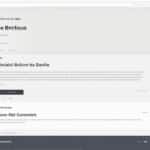Table of Contents
If you’ve ever browsed the internet, you’ve undoubtedly encountered a URL. URL stands for Uniform Resource Locator, and it’s a crucial component of internet navigation. It’s a web address that identifies the location of a specific resource on the internet, such as a website or a page within a website. In this guide, we’ll provide a comprehensive introduction to URLs through real-life examples, illustrating their significance in internet navigation.
Key Takeaways
- A URL is a web address that identifies the location of a resource on the internet
- Understanding URLs is essential for internet navigation
- The components of a URL include the scheme, domain, path, and query parameters
- Real-life examples of URLs can help you comprehend their usage in different contexts
- By understanding URLs, you can navigate the internet with confidence and access the resources you seek
What is a URL?
A URL stands for Uniform Resource Locator. It is a web address that provides a unique identifier for a specific resource on the internet. The primary purpose of a URL is to allow users to locate and access web pages, images, videos, and other online content quickly and efficiently.
The importance of URLs in identifying web resources cannot be overstated. They enable the user to navigate through the vast expanse of the internet and locate specific resources with ease. URLs serve as a form of an address for online resources similar to how street addresses function for physical locations. Through the use of URLs, we are able to access content hosted on servers globally no matter where we are in the world.
By understanding the fundamentals of a URL, you can better comprehend various examples and navigate the internet effortlessly.
“The internet is becoming the town square for the global village of tomorrow.”
-Bill Gates
Structure and Components of a URL
Now that we understand what a URL is, let’s have a closer look at its structure and components. A typical URL consists of four parts:
Scheme
The scheme indicates the protocol used to access the resource, such as HTTP, HTTPS, FTP, etc. For instance, in the URL “https://www.example.com”, the scheme is “https”.
Domain
The domain is the primary identifier of the resource, indicating the location of the website or server. In the previous example, the domain is “www.example.com”.
Path
The path refers to the specific location of the resource on the web server. It often includes various subdirectories and filenames. For example, in the URL “https://www.example.com/services/seo”, the path is “/services/seo”.
Query Parameters
Finally, query parameters provide additional information about the resource, such as search terms, filters, or preferences. They are separated from the rest of the URL with a question mark and can contain multiple parameters, each with their own name and value. For instance, in the URL “https://www.example.com/search?q=seo&lang=en”, the query parameters are “q=seo” and “lang=en”.
It’s essential to note that the order of these components can vary depending on the type of URL, and some parts may be optional or omitted altogether. Nonetheless, having a basic understanding of URL structure and components is vital for effective internet navigation and web development.
Real-life URL Examples
URLs are the backbone of the internet, acting as unique identifiers that point to specific online resources. In this section, we will showcase several real-life URL examples across different contexts that will offer insights into how URLs are structured and leveraged on the internet.
Website URLs
One of the most common examples of URLs are website addresses. Take, for instance, the URL for Amazon UK: https://www.amazon.co.uk/. This URL consists of four distinct components:
| Component | Description |
|---|---|
| Protocol | https:// specifies the protocol being used to access the resource – in this case, the Hypertext Transfer Protocol Secure. |
| Domain | www.amazon.co.uk identifies the location of the resource and the specific web server hosting it. |
| Path | The path / specifies the node within the resource’s hierarchy being accessed – in this instance, the homepage of the Amazon UK website. |
| Parameters | There are no parameters in this particular example. |
Other website URLs may contain additional parameters, such as search terms or session identifiers, that help refine the resource being accessed.
Article URLs
URLs are also used to access specific online articles. For example, the URL for a recent article on the BBC news website titled “Covid-19: Inside the UK’s biggest vaccination centre”, is as follows: https://www.bbc.co.uk/news/av/uk-england-merseyside-55989014
In this URL, we can identify similar elements as in the Amazon UK URL. However, the structure of these components may differ, depending on the website’s configuration and the page hierarchy.
Dynamic URLs with Query Parameters
Finally, URLs can also be dynamically generated, using parameters to customize and modify the resources being accessed. For example, when conducting a search on Google, the resulting URL will likely contain query parameters, indicating what was searched for. An example of this would be:
https://www.google.com/search?q=seo+writing+ai&oq=seo+writing+ai&aqs=chrome.0.35i39j69i60.2620j1j7&sourceid=chrome&ie=UTF-8
In this URL, the query parameter is “q”, with “seo+writing+ai” indicating what was searched for on Google.
From these examples, it is clear how URLs make it easy to locate and access specific information online.
Conclusion
Through this comprehensive guide, we aimed to enhance your understanding of URLs and their significance in internet navigation. We discussed the basics of a URL, its structure and components, and explored real-life examples to provide a practical perspective. By comprehending these concepts, you can now confidently navigate the internet, utilizing URLs to access the resources you seek.
Remember, the ability to comprehend URLs will not only benefit your online experience but also offer a better experience for your visitors if you operate a website. URLs play a critical role in SEO and can impact your website traffic, so it’s crucial to understand their significance.
We hope this guide has been informative and helped you gain a better understanding of URLs and their role in internet navigation. If you have any questions, comments or feedback, please don’t hesitate to reach out to us. Thank you for reading!
FAQ
What is a URL?
A URL stands for Uniform Resource Locator. It is the web address that identifies the location of a specific resource on the internet.
What are the components of a URL?
A URL comprises several components, including the scheme (e.g., https://), the domain (e.g., www.example.com), the path (e.g., /blog/post), and optional query parameters (e.g., ?id=123).
URLs are used to access web pages and resources on the internet. By entering a URL into a web browser’s address bar, the browser sends a request to the corresponding server, which then responds by displaying the requested resource.
Can you provide some real-life examples of URLs?
Certainly! Here are a few examples of URLs:
1. Website URL: https://www.example.com
2. Web page URL: https://www.example.com/products
3. Article URL: https://www.example.com/articles/how-to-guides
4. Dynamic URL with query parameters: https://www.example.com/search?q=keyword&page=1
What is the importance of understanding URLs?
Understanding URLs is vital for effective internet navigation. By comprehending the structure and components of a URL, you can decipher web addresses, access desired resources, and navigate the online world efficiently.













